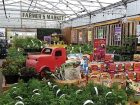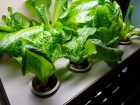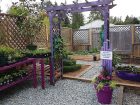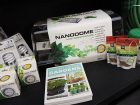
Features
Business
Retail
Inspire edible growth at retail year-round
Attracting new customers who seek to grow their own food is different from selling to familiar customers
March 4, 2019 By Shelley Levis
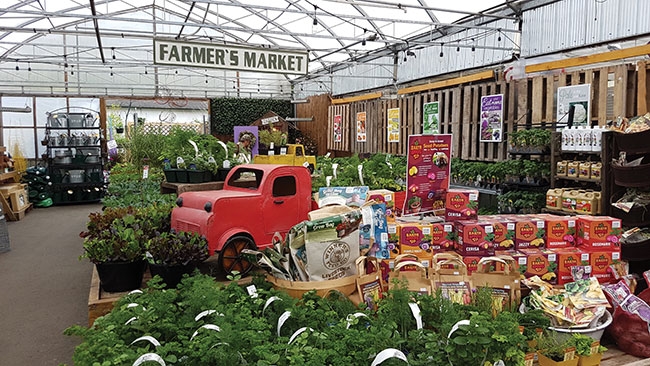 Add colour to the vegetable department with props and products
Add colour to the vegetable department with props and products As garden centre owners and seasonal edible growers, our window to capitalize on sales is limited to just a few short months each year. But, it doesn’t have to be. With the proper products and a little marketing, you can triple your edible sales and increase repeat customer traffic throughout the year.
I wear a lot of hats in the nursery industry, from buyer to manager to garden writer. My experience has taught me that just carrying edible plants isn’t enough to encourage year-round sales. Once the peak spring season is over, we are limited to a small bump of edible sales in late summer through our fall transplants, and from there it takes a nose dive until the following year.
Developing a marketing strategy, incorporating inspiring displays and stocking easy-to-use products are key to increased sales. Attracting new customers seeking to grow their own food is not the same as selling to customers who have been coming to your garden centre for years.
Increasing sales goes beyond simply carrying plants and products. Efforts need to be made to create inspiring displays that entice people to grow their own food. As gardeners ourselves, our long tables of fresh leafy green veggie packs scream potential. We don’t just see the tender first leaves of broccoli or tomato plants, we can visualize the vegetable itself. This is not the case with our customers. If you were able to view this through their eyes, all you would see is a table of small green plants.
Incorporating colour and visual print media that describes the benefits of growing different vegetables encourages customers to shop in an otherwise completely green department. Use creative displays that signal ‘homegrown’ and ‘organic’ to further inspire first-timers to try their hand at growing their own food.
Understand the wide range of customers you are trying to appeal to. Don’t just gear your displays toward experienced gardeners. Think of the middle-aged fellow who prides himself as the king of the BBQ and loves to grow hot peppers for his famous BBQ sauce. Or a young mother who is trying to find a wholesome hobby to enjoy with her family. By visiting your edibles department, she could pick out some easy-to-grow vegetables that she can plant with her kids.
This past year, I decided to renovate an area just behind the annual greenhouse and created four small-space garden designs. This zone had previously been shut off to the public and was literally a dumping zone for fixtures and pallets that needed to be hidden from view. There isn’t a nursery on the planet that doesn’t have an area like this. How can you turn an otherwise useless space into something that sells your products?
To see vegetable plants growing in a realistic garden setting allowed customers to visualize how they could incorporate this into their own gardens. It also became an area where we could hold seminars, park extra plant carts during the peak season and showcase other products like raised planter boxes, garden stakes and trellises.
Educating customers with living displays resulted in higher sales and repeat visits. Marketing in our industry is not just about selling plants, it’s about selling an experience. Our customers can easily buy vegetables from a grocery store and not get their hands dirty. What they desire when they purchase edible plants is the feeling they get when they are the creators of their own food.
Later in the season, when a customer came to us seeking answers about why their zucchini plant was all flower and no fruit, we were able to walk them to our display gardens and educate them visually about the difference between a male and a female flower. The gardens were planted again for fall harvest, giving us a minimum of three seasons to promote edibles.
RELATED
- Marketing to the lazy gardener
- Small new edibles pack big flavour
- Growing trends in the garden 2018/19
In the writing of my book Countertop Gardens, I focused on indoor growing devices and various companion products, many of which were offered at the independent garden centre I manage. Over the course of a year, I tested these products and shared the findings in my book, complete with photographs and step-by-step instructions. Currently displayed in our edibles and growing department alongside our seeds, devices and growing media, the book serves as a good reference for both staff and customers. The staff use it daily as a manual and how-to instructional guide when working with customers to find products best suited for their growing needs.
If you are going to carry supplies that encourage growing indoors and gardening throughout the year, then be sure to provide instructions on how to use them. Simplify the fertilizers, growing media and various growing trays and domes to just a few that remain on display year-round.
As buyers for our stores, it’s easy to get carried away with all the latest products on the market, however, this can actually kill sales if we overwhelm the customer with too many choices.
The emerging trend for the home gardener is hydroponics. This form of gardening is mostly foreign to retail garden centres since we focus most of our products around containers or garden beds when it comes to edibles. To help the customer, I explored this growing method in my book and trialed products that are simple to use for the beginner. While this category brings with it a whole new kettle of fish, we can choose to carry some simplified products and fertilizers. Easy options can assist customers looking to get started in hydroponic growing.
In an effort to increase sales year-round, continuous marketing of growing media, seeds and various devices need to go beyond our peak months. Holidays and special occasions are great times to help customers see the potential of these products as gifts. Have a tray growing microgreens at all times and a mason jar with sprouts on the go parked beside your year-round seed rack. Then post it on Facebook and Instagram, feature it in newsletters and promote instore sales with full-colour graphics.
Once customers come to identify your garden centre as the go-to for growing products all year long, they will choose to shop at your store over big box centres that pack up gardening merchandise to make room for the next big season.
Marketing Strategies
- Target customers in the 25-45 age range to include professionals, foodies, youth and household decision makers by promoting the benefits of growing their own food.
- Create dynamic displays that inspire your customers to grow. Make them ‘Instagram’ worthy.
- Don’t just talk to customers about gardening with edibles, show them.
- Get online and get social.
Shelley Levis is a horticulturalist, speaker, garden writer and foodie in Langley, BC. Her book, Countertop Gardens is available internationally in Australia, the UK, and North America. Visit Amazon or email Kristina at kkoski@mandagroup.com for wholesale inquiries. For more from Shelly, visit sowanddipity.com.
Print this page
